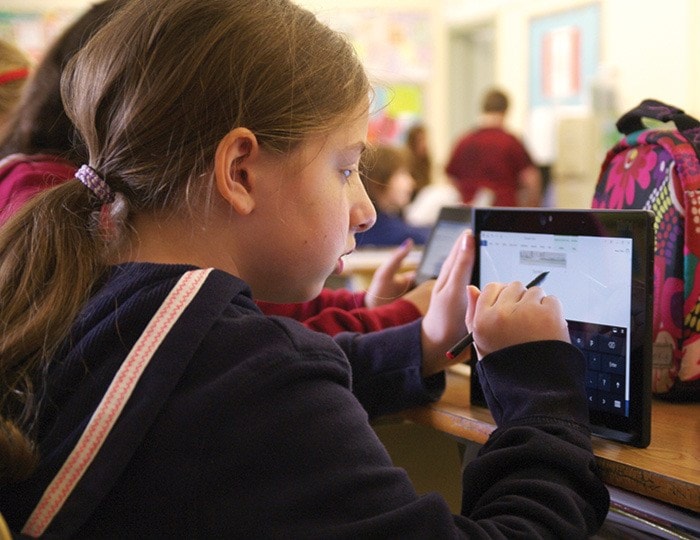Maren Longman sat quietly in her Grade 5 class at Alberni Elementary School working intently on her project report.
Longman assembled her project’s pieces: text, pictures and a video, then handed it in to teacher Luke McIvor.
But this isn’t an ordinary school report—at least it’s not the kind or report that parents remember doing when they were in elementary school.
Longman and 27 other students in McIvor’s class assembled their reports on computer tablets supplied by School District 70.
The class is part of a pilot project that integrates tablets into a classroom for teaching math, science, social studies and French. If successful, tablets could one day be introduced into all SD70 classrooms.
“Most of the kids already have this kind of technology at home so it’s already a part of them,” McIvor said. “This is learning in the 21st century.”
The initiative came about in September, SD70 Director of Instruction and IT, Jack Hitchings said. District officials wanted to know how technology such as tablets would work in a classroom setting.
McIvor’s class was chosen, Hitchings said, because he was a dynamic teacher who believed in technology and learning and was willing to work with the IT department. “A lot of people would like to have them but there’s only so many to be had.”
The district bought 27 tablets with $10,000 from the Ministry of Education’s ‘Education Plan’ category which funds personalized learning and technology projects among others, Hitchings said.
Tablets were chosen instead of iPads because they’re more versatile and can integrate with both the school hardware and software network. “IPads are a more personal device than a hardware device and there are issues with running our programs on them,” Hitchings said.
 McIvor previously taught school curriculum using text books and photocopied sheets. But he observed several things. A lot of books were out of date. Some students didn’t want to read. Others read at an incongruent rate but hid it by looking at the same books other kids were reading.
McIvor previously taught school curriculum using text books and photocopied sheets. But he observed several things. A lot of books were out of date. Some students didn’t want to read. Others read at an incongruent rate but hid it by looking at the same books other kids were reading.
The tablets were integrated into McIvor’s class last November. He still uses books and the dry erase board to teach lessons, but now he intersperses learning with tablets.
“Right away, the kids were more engaged, more interactive and they had more fun learning this way,” McIvor said.
At first, only enough tablets were supplied for half of the class so McIvor had his students group up for lessons. But the move took away from personalized learning.
Kids had different ideas about how projects should be done or worked at different rates.
When researching projects, gone is the old wooden cabinet with drawers of flashcards classified using the Dewey Decimal System.
Instead, students log onto SD70’s digital classroom where they can log onto research sources such as Ebooks, Learn 360, TumbleBook Library, Historical Canada and Kid Search as well as a host of others.
Students are more engaged with their learning, more excited and eager to share what they’ve learned. But McIvor noticed another benefit. Kids who read at a different rate used to grab the same books as other students to hide the fact that they read slower than others. “It got reluctant readers to read because with a tablet they can read at their own level without anyone noticing,” McIvor said.
Alberni Elem. isn’t the only school that integrates computers into learning. There are other small projects at AW Neill Middle School, as well as Eighth Avenue and Gill Elementary Schools.
An example of how the tablets are used with lessons is the project students did for social studies.
McIvor had students research the Parliament Buildings in Ottawa.
Using their tablets, students gleaned information from the Internet and wrote about what they were, where they were and who works there. They chose pictures of the building to go with the report as well as a video.
“They were better able to grasp the concept and bring the lesson to life through the tablets,” McIvor said.
McIvor was careful to point out that the tablets aren’t for play. “Whether it’s pics, videos or games the lessons are all thoughtfully chosen,” he said. “They can play math or spelling games against other kids in class, or even against kids in other provinces.”
Accessing the Bescherelle—or French book of verbs—is important to McIvor, who teaches French Immersion. “It has a tonne of resources available inside the tablet instead of bulky books,” he said.
Using tablets connects students with mainstream learning and makes learning personally relevant for students. Students can write on pages in a tablet but can’t in a book, and books cost money to replace.
But using tablets isn’t without challenges, McIvor said.
The tablets use Wi-Fi and there can be connection problems, or there can be issues with the SD70 network. And because it’s only a pilot project McIvor has to balance continuing use of traditional learning resources.
But the tablets have made their mark. “It’s hard to pin-point why but it’s part of their world. It’s like camp but with technology so it’s cool for them no matter what the subject is,” McIvor said.
With two months left in the school year the project will be winding down to a close and will soon be assessed for its effectiveness.
“Students aren’t learning differently so much as they are engaging with learning differently,” Hitchings said.
“Based on what Luke says though we know that they can make a difference.”
reporter@albernivalleynews.com
Twitter.com/AlberniNews
